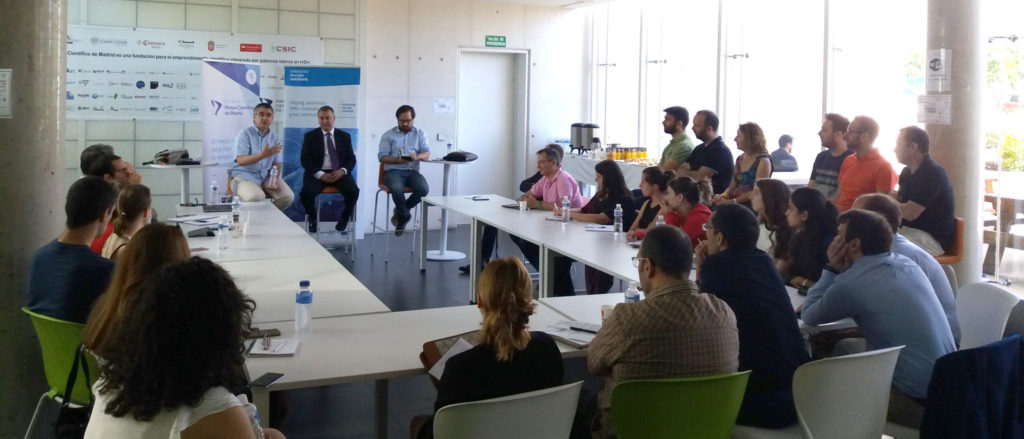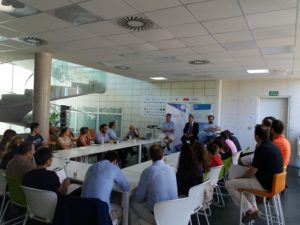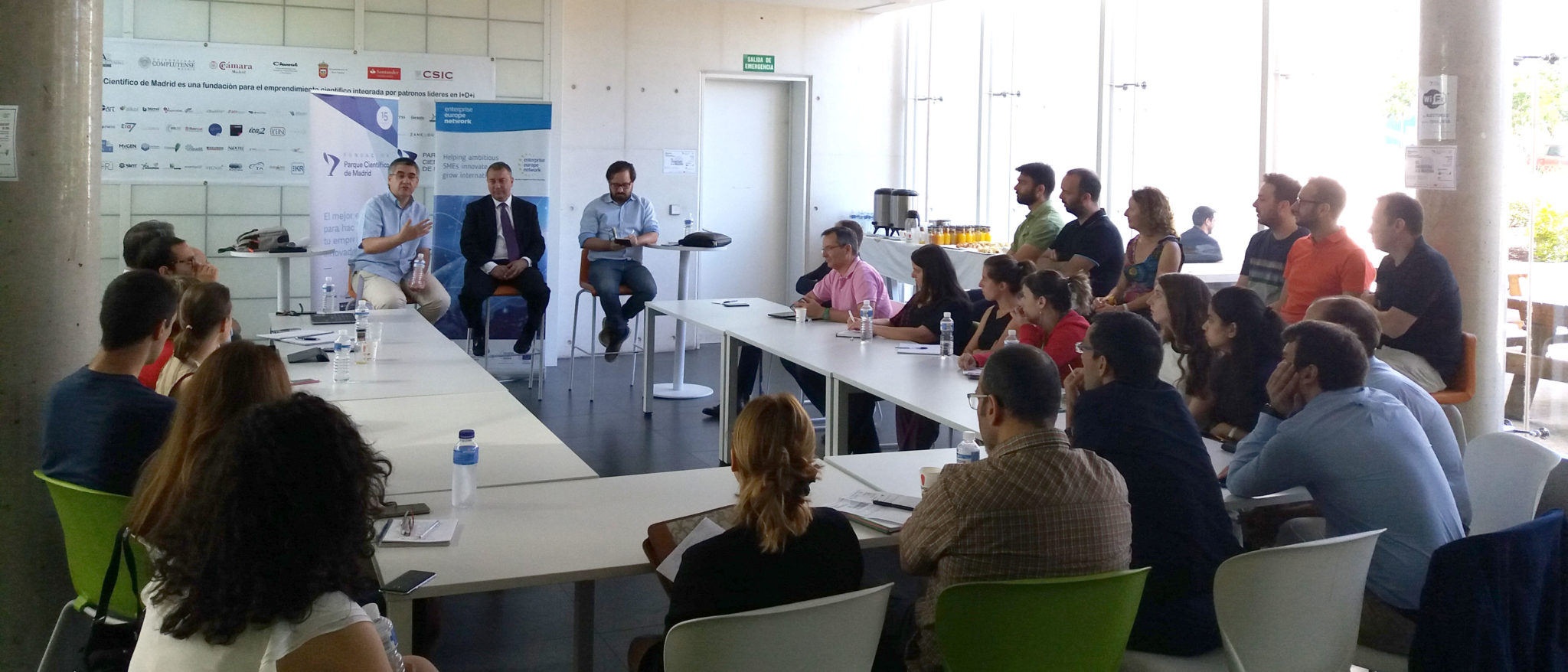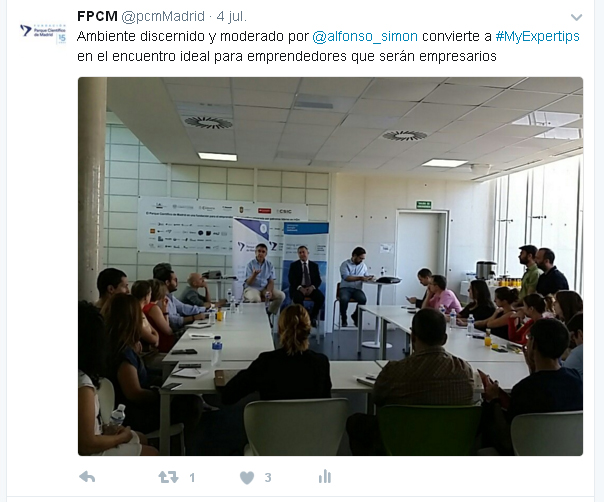In business, as in life, the best way to learn is through one’s own experience; the second is to learn from others who have already lived it. There’s also a third way: learning from all the literature that exists around the business world. But if you’re looking for practical learning, listening to more experienced others helps avoid mistakes and increases the chances of success in new challenges to face.
With this premise, #MyExperTips is born, an initiative that seeks to take advantage of the expertise of more mature companies that have passed through the Madrid Science Park, to provide new technology-based companies (NTBCs) with a list of very practical recommendations about the major milestones a company goes through until reaching the market.

From Laboratory to Industry, Two First-Hand Examples
In the first meeting, we talk about the change that leaving their laboratory in the Park (or any other business incubator or accelerator) to continue their journey in their own facilities means for a company. A natural step for any growing scientific company, but one that must be approached in the right ways and at the right times. 
For the debate, we have the founders of two companies that have recently set up their own facilities after spending their first stage at the Madrid Science Park. Rafael Ferrito from NanoInnova and Antonio Delgado from Natac explained to the attendees firsthand the advice they would have liked someone to have told them during this process.
Nanoinnova Technologies is a nanotechnology company, a spin-off from the Autonomous University of Madrid, specialized in research, development, and commercialization of new innovative materials. Their most advanced studies mainly focus on the development of carbon nanotubes and graphene sheets of great technological interest with industrial applications.
After their time at the Madrid Science Park, the company has decided to set up its own industrial plant outside Madrid.
For its part, Natac is a Spanish biotechnology-based company dedicated to the research, development, and commercialization of plant-based extracts, especially ingredients derived from olive and grape. The ingredients produced by Natac have applications in the pharmaceutical, food, nutraceutical, animal feed, and cosmetic industries.
With the recent opening of its own headquarters in Madrid and two factories in Córdoba and Ciudad Real, dedicated exclusively to the development of olive and grape-derived ingredients (Innovaoleo and Alvinat), Natac is in the process of national and international expansion.
As moderator, we had the experienced economic journalist from Cinco Días, Alfonso Simón. He was in charge of navigating through the past, present, and future of the two invited companies.
Advice When Setting Up Your Own Facilities
Better a Location Suitable for Business Activity
The Spanish real estate market offers companies an ideal situation with a wide variety of warehouses and offices for sale and rent: “We haven’t had major difficulties in setting up in an industrial warehouse or laboratory, the available land supply, outside Madrid, is enormous”
However, depending on the company’s activity, it’s possible that having certain utility connections or permits determines the suitability of facilities: “We look for industrial warehouses, laboratories or facilities that are ready to operate from day one, although you always have to invest in renovations, it’s important to reduce paperwork“.
Another variable to consider is the location “after a study we saw that the competitive advantage was in working close to the raw material, in our case it was essential to take advantage of its freshness and shorten processing times to give quality to our extracts“.
Don’t Rush to Have Your Own Facilities. Don’t Be Afraid to Grow Either.
Having your own infrastructure means an increase in the company’s fixed expenses, which makes it important to study carefully the right moment to undertake it: “there is no irrefutable financial or economic rule that determines your optimal level of debt, it will be that level that lets you sleep peacefully (you or your financial director)”. However, a It’s easy to fall into the error of making excessive investments that you don’t need in the short term, no matter how useful they may seem in the long run.
When you’re small, it’s unfeasible to be outside (of a laboratory or industrial incubator): the necessary investment in infrastructure and equipment is unattainable. That’s why they emphasize when investing in industry, never put the cart before the horse, prudently delay as much as you can strong investments like that.

But in the same way, they reaffirm when you have grown enough and have accumulated complexity, investing in your own facilities and concentrating costs can be profitable and add not entering the market when you have grown and are already prepared by staying in a protected environment, such as an incubator, would have been much worse than the vertigo of the leap.
In short, the leap to investments and own industry can cause vertigo at first, but there is light if one acts with rationality and prudence: In our case, we took about a year to mature the decision to make the leap from the laboratory to the industry and to find the location.

Better accompanied than alone
As happens in the first steps of a company, where a cooperative and supportive environment like a Science Park helps start-ups to establish themselves, when the company grows, having collaborative partners is usually a success: You should always try to ally yourself with leaders and experts in each market and each product, they are the ones who understand their peculiarities and can provide you with the advantages of those niches.
Furthermore, when you have to find your own market because you’re developing a new technology, a collaborator can become that driving partner who believes in the project like you do and helps you commercialize it. Therefore, cooperating and creating joint ventures is usually positive It has helped the company significantly reduce installation and manufacturing costs for this reason, neither of them would ever recommend a developing company to make an investment alone.

Although experience has also taught them that when you look for an industrial partner, pay attention to how you share your knowledge: When you outsource manufacturing, you can’t transfer your core carelessly, it’s as relevant to your future as R If you have no choice but to outsource, do it wisely and thinking about the future . In their particular case, they chose to manufacture themselves: Finally, we made the decision to manufacture, instead of outsourcing, and for us it was a complete success.
The rules of the game change when you run an industrial company
It’s important to assimilate that the aura of a novel or disruptive project that accompanies start-ups disappears when the company grows and has an industrial focus: The paradigm shift affects both management and the technical team. We still find it difficult for them to understand that the ways of doing things that had worked until now need to be changed . In short, you have to understand that the market is actually what determines the pace and future of the company. In our case, it’s allowing us to grow “.

4 extra tips from experience
The early source of income for a new company usually doesn’t coincide with the R that you want to exploit.
The initial business model of a company suggests that scientific-technological developments will be the basis of the business. However, from the beginning we saw that manufacturing was the recurring source of income, it wasn’t economically rational to dedicate ourselves only to RD.
As a result, the start-up that is now an established company has little to do with the one they designed in that first business plan: We decided to give up investing large sums in R projects that were very attractive but uncertain and required long maturation periods. We opted for the generation of early income that sustained current expenses. In short, generating cash from the first moment.
But that doesn’t mean they leave aside their research essence: We combine the most innovative medium-term projects (supported with RDI incentives) with short-term income generators.
They won’t take your technology out of your hands.
Scientific-technological companies are immersed in their developments, when the time comes to approach the customer they discover that they had forgotten about commercialization. “After strong product or service development, you encounter the market and realize how little effort you’ve invested in marketing“.
It’s then when the question arises of why they should buy from me instead of my competitor: “My mistake was believing that my innovative development would eclipse the market, but the market speaks its own language” and this is usually not as optimistic as the entrepreneur’s expectations. “Easily, market access times double, as do the deadlines for signing agreements with large corporations“.
Persevering attitude without obstinacy
Entrepreneurship, especially if it’s a new technology-based company (NTBC), is a project that demands consistency and determination. However, the good entrepreneur should not be obstinate in their linear vision; they must have a broad perspective to notice what’s happening around them and be able to adapt. That ensured our viability “. The reason is none other than “the financial plans of start-ups are usually not valid due to the great variability they are subjected to“.
Understand the roles of large companies
The future of a company, especially when it’s growing, may involve signing a contract with a multinational. In large companies, departmental interests and barriers are more relevant than the apparent general interest of the company.
A large company can be a labyrinth for an innovator, making them lose 2 or 3 years of work without any results. Often we believe it’s enough to win over the technical area of the company. However, we need to convince those who have influence in decision-making, and unfortunately, this doesn’t usually coincide with the technical team “.
Each company is different, and these tips may not be applicable in all cases. But we are sure they will be a good starting point for any small scientific-technological company considering setting up its own manufacturing plant to assess its viability.














































